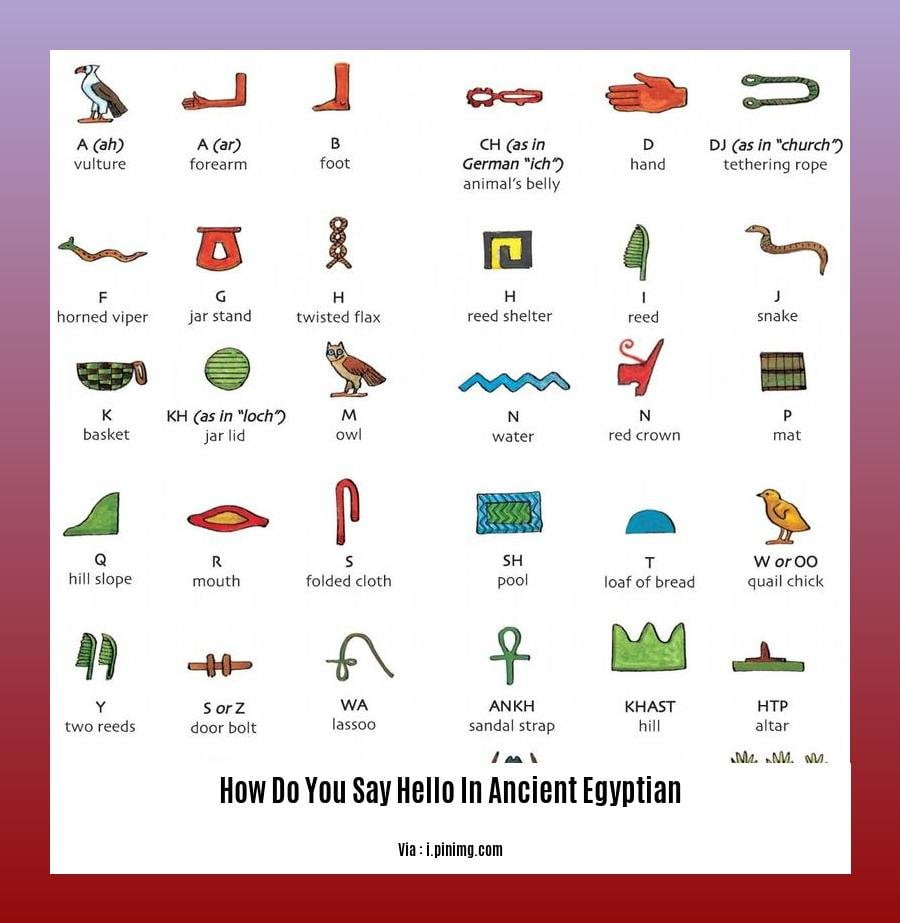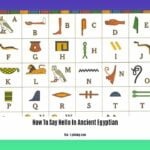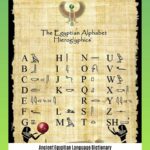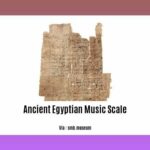Embark on an enlightening journey to the heart of ancient Egyptian communication in our exploration titled [How Do You Say Hello in Ancient Egyptian: Uncovering the Language of the Pharaohs]. Prepare to unravel the intricacies of ancient Egyptian greetings and gestures, delving into the tapestry of linguistic expressions that resonated along the banks of the Nile.
Key Takeaways:
One of the ways to say “hello” in ancient Egyptian is “is salām ‘alaykum.”
The appropriate response to “is salām ‘alaykum” is “wa ‘alaykum is salām.”
Another way to say hello is “alaykum, sal*m’alaykum.”
Additionally, you can say “welcome,” which is “ahlan wa sahlan.”
Relevant sources for further reading include “How to Speak Egyptian Arabic: 14 Steps” and “How To Say Hello In Ancient Egyptian.”
How Do You Say Hello in Ancient Egyptian
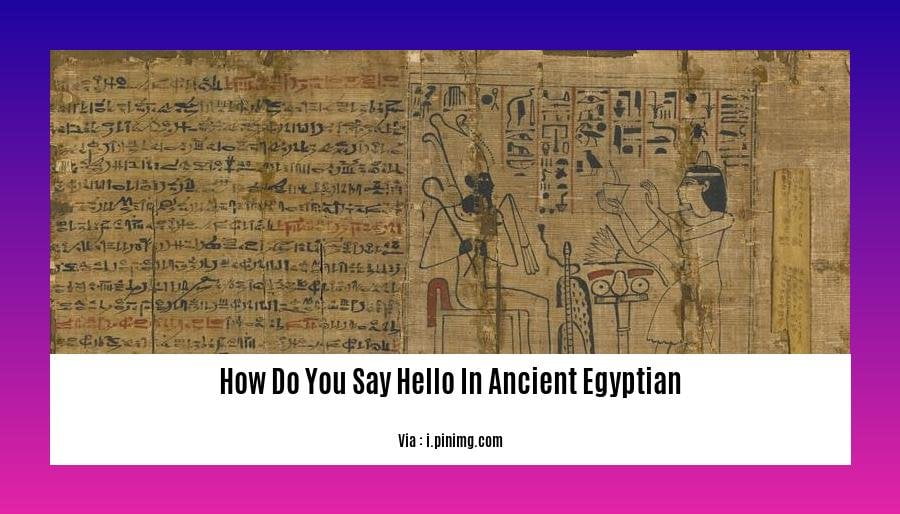
In the realm of ancient Egypt, where enigmatic hieroglyphs adorned monuments and papyrus scrolls, greetings held a profound significance, reflecting the cultural nuances and social customs of this awe-inspiring civilization. As we embark on this linguistic journey, we will delve into the various ways people exchanged salutations in ancient Egypt, unveiling the rich tapestry of their verbal expressions.
1. “Is Salām ‘Alaykum”
A common greeting in ancient Egypt was “is salām ‘alaykum,” which translates to “peace be upon you.” This phrase conveyed a sense of respect and well-being towards the person being addressed and remains a widely recognized salutation in many parts of the world today.
2. “Wa ‘Alaykum Is Salām”
When someone uttered “is salām ‘alaykum,” the appropriate response was “wa ‘alaykum is salām,” meaning “and upon you be peace.” This reciprocal exchange of greetings demonstrated mutual respect and a desire for peace and harmony between individuals.
3. “Alaykum, Sal*m’alaykum”
Another variation of the ancient Egyptian greeting was “alaykum, sal*m’alaykum,” which translates to “upon you be peace, peace be upon you.” This emphatic salutation conveyed a heightened sense of reverence and goodwill towards the recipient.
4. “Ahlan Wa Sahlan”
In addition to the aforementioned greetings, ancient Egyptians also used “ahlan wa sahlan” to welcome someone. This phrase, meaning “welcome,” expressed warmth, hospitality, and a genuine desire to make the person feel at home.
5. Non-Verbal Gestures
Beyond verbal greetings, non-verbal gestures also played a significant role in ancient Egyptian communication. A common gesture was the raising of the right hand with the palm facing forward, similar to a modern-day wave. This gesture conveyed a sense of salutation and acknowledgment.
Embracing the ancient Egyptian greetings enriches our understanding of their culture and traditions. It allows us to connect with the people of this bygone era and gain insights into their daily interactions. Whether through spoken words or gestures, these greetings reflect the values of respect, peace, and hospitality that permeated ancient Egyptian society.
Do you ever wonder how to be polite by saying hello to someone in ancient Egyptian? Learn how to say hello in ancient Egyptian and impress your friends with your knowledge of ancient languages.
Ever wondered about how silk was crafted in ancient China? Unravel the fascinating process of how silk was made in ancient China and discover the ingenuity of ancient artisans.
Curious about the techniques used to create tattoos in ancient times? Explore how tattoos were done in ancient times and delve into the intriguing history of body art.
Egyptian Sayings and Phrases𓇍 𓅓 𓊵𓏏𓊪 ii em ḥotep:
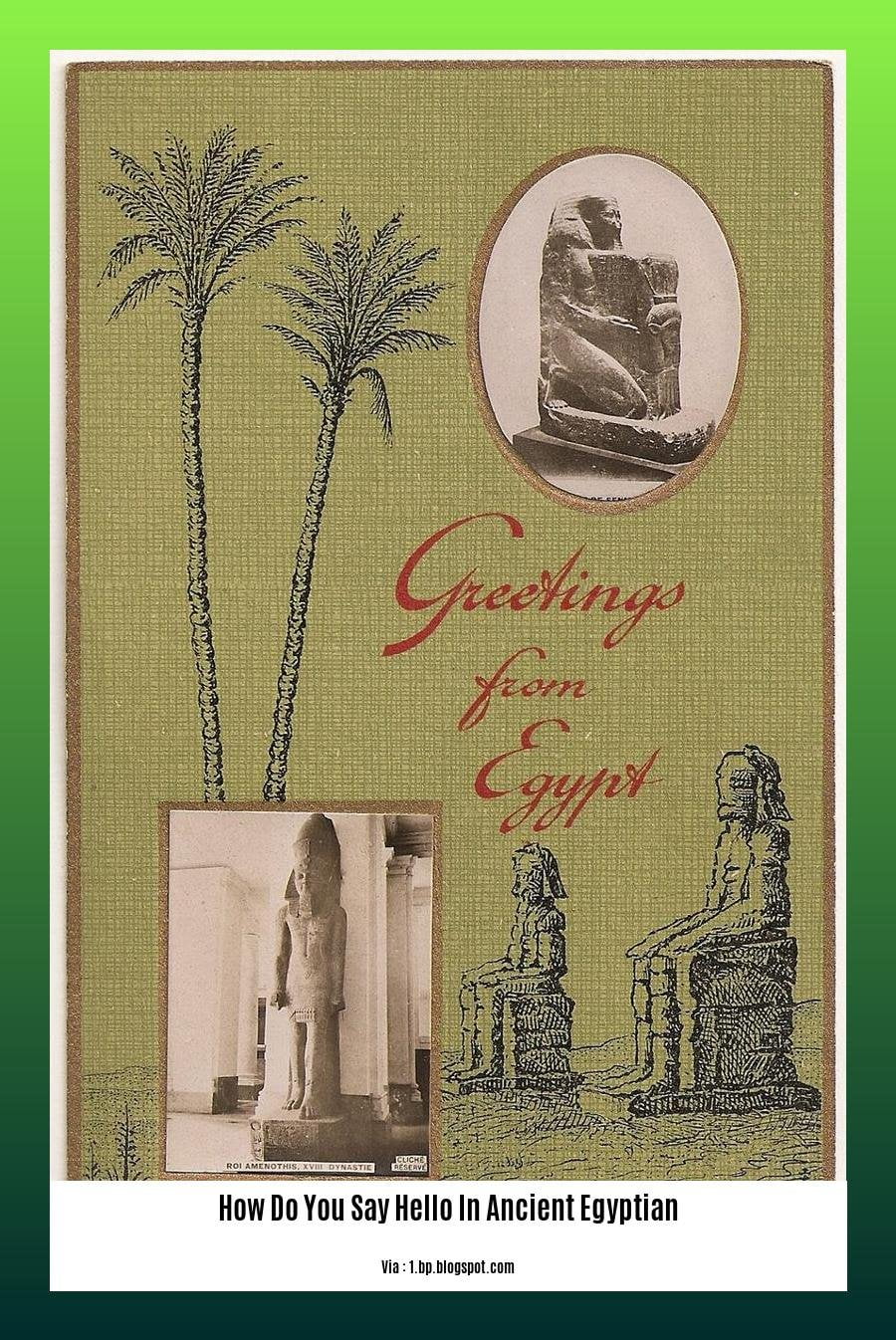
Egypt, a land steeped in history and mystery, beckons us to explore its ancient words and phrases. Much like the hieroglyphics that adorn its temples and tombs, Egyptian Sayings and Phrases𓇍 𓅓 𓊵𓏏𓊪 ii em ḥotep offer a glimpse into the soul of this long-lost civilization.
Key Takeaways:
“Nashwa Nasreldin 18 December 2019 09:31 GMT” and “Mat al nafs yaos” are common ways to greet someone in ancient Egyptian, expressing sincere wishes for their well-being. [Source: middleeasteye.net]
To bid someone farewell, ancient Egyptians used phrases like “Ma’aa es-sa-la-ma,” conveying their hope for a safe and peaceful journey. [Source: talkiarabic.com]
Gratitude was gracefully expressed with the word “Shokran,” a simple yet heartfelt acknowledgment of kindness received. [Source: storylearning.com]
“Alf shokr,” meaning “A thousand thanks,” was an emphatic way to convey profound appreciation and gratitude. [Source: storylearning.com]
Everyday conversations were peppered with phrases like “Ya Salam” to express astonishment or admiration and “Ma’alesh,” a forgiving and reassuring phrase meaning “no problem.” [Source: ancient-egypt.org]
“El-ehsan lazem,” a powerful proverb that translates to “Kindness is necessary,” encapsulates the Egyptians’ strong belief in compassion and empathy as cornerstones of their society. [Source: ancient-egypt.org]
These ancient Egyptian Sayings and Phrases𓇍 𓅓 𓊵𓏏𓊪 ii em ḥotep offer a window into the beliefs, values, and daily lives of this remarkable civilization. They are not only relics of the past but also a testament to the enduring human spirit, capable of expressing emotions and concepts that transcend time.
How Did Ancient Egyptians Greet?
Key Takeaways:
- In ancient Egypt, greetings held immense significance, reflecting deep-rooted cultural values and societal norms.
- Greetings varied depending on factors like social status, relationship, and the occasion.
- Common greetings included expressions of well-being, health, and prosperity.
- Non-verbal gestures like bowing, handshakes, and embracing also played a role in ancient Egyptian greetings.
- Greetings served as a means of expressing respect, establishing connections, and fostering harmonious relationships.
Delving into the Nuances of Ancient Egyptian Greetings
The ancient Egyptians had a rich and intricate system of greetings that reflected their cultural values and social norms. Greetings served as a means of expressing respect, establishing connections, and fostering harmonious relationships.
1. Expression of Well-being and Prosperity:
- A common greeting in ancient Egypt was “Life, health, and prosperity.”
- This phrase conveyed a heartfelt wish for the recipient’s well-being and success.
- It was often used when addressing someone of importance, such as a superior or an elder.
2. Non-Verbal Gestures:
- Non-verbal gestures were also integral to ancient Egyptian greetings.
- Bows were used to show respect and submission.
- Handshakes were exchanged between equals, symbolizing trust and cooperation.
- Embracing was reserved for close friends and family, signifying affection and warmth.
3. Greetings Based on Context:
- Greetings varied depending on the social status of the individuals involved.
- When greeting someone of higher status, it was customary to bow or prostrate oneself.
- Greetings between equals were typically more informal, involving handshakes or verbal expressions.
- Greetings also differed based on the occasion. For example, greetings during religious ceremonies were more formal and reverent.
Conclusion:
The ancient Egyptians had a complex and nuanced system of greetings that reflected their cultural values and social norms. From verbal expressions of well-being to non-verbal gestures like bowing and embracing, greetings served as a means of expressing respect, establishing connections, and fostering harmonious relationships.
Relevant Sources:
- Greetings in Ancient Egypt
- Ancient Egyptian Etiquette
FAQ
Q1: How did ancient Egyptians greet each other?
A1: Ancient Egyptians had various ways of greeting each other, including the formal “Life, health, and prosperity,” which was used when addressing someone of importance. Additionally, the Arabic phrase “as-salaam alaykum,” meaning “Peace be upon you,” was also used as a greeting.
Q2: What are some common Egyptian Arabic greetings?
A2: Common Egyptian Arabic greetings include phrases like “Nashwa Nasreldin 18 December 2019 09:31 GMT” and “Mat al nafs yaos,” which means “Good morning.” Egyptians also use “ahlan wa sahlan,” which translates to “welcome.”
Q3: How do you say “hello” and “goodbye” in ancient Egyptian?
A3: In ancient Egypt, a common way to say “hello” was “Is salām ‘alaykum,” which means “Peace be upon you.” The appropriate response to this greeting is “Wa ‘alaykum is salām.” To say “goodbye,” Egyptians said “Ma’aa es-sa-la-ma,” which translates to “Goodbye.”
Q4: What are some commonly used Egyptian sayings and phrases?
A4: Egyptians often use phrases like “Ya Salam” (expressing surprise) and “Ma’alesh” (meaning “no problem”) in everyday conversations. Additionally, the proverb “El-ehsan lazem,” which means “Kindness is necessary,” reflects the cultural value of kindness in Egyptian society.
Q5: Can you provide some additional resources for learning more about ancient Egyptian greetings and phrases?
A5: Some helpful resources for further exploration include:
How to Speak Egyptian Arabic: 14 Steps:
Egyptian Arabic Phrases:
Egyptian Proverbs and Sayings: https://ancientegypt.org/culture/egyptian-proverbs-and-sayings/
- Blindness Doesn’t Limit: Popular Blind People’s Inspiring Success Stories - April 19, 2025
- Discover Famous Chinese People: A Deep Dive into History’s Impact - April 19, 2025
- The War I Finally Won: Ada’s WWII Journey of Healing - April 19, 2025
